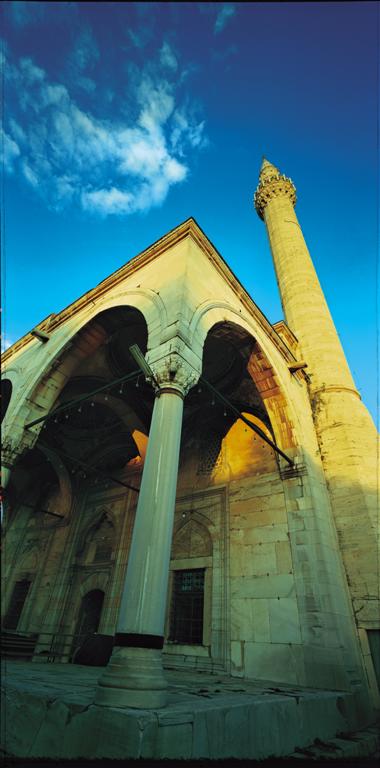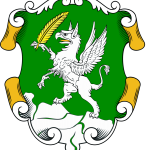The Mustafa Pasha Mosque stands in the vicinity of the Skopje Fortress (Kale). The inscription above the entrance to the mosque states that it was built in H.898/M.1492 by Mustafa Pasha (son of abdulah), a vizier and one of the prominent personages in the ottoman state during Sultan Bayezid ii(1481-1512) and Sultan Selim I (1512-1520). The building of this edifice is also confirmed in the waqfname of its legator legalized in H.920/M.1514-15. The Mustafa Pasha Mosque is undoubtedly one of the most resplendent sacral Islamic buildings in the Balkans.
It can be seen from all the vantage points in the city due to its dominant position and its monumentality. The mosque complex once consisted of a caravanserai, a medresse, an imaret (communal soup kitchen), a mekteb (an elementary school for teaching children in Islamic subjects) and a tűrbe; today, only the mosque, the tűrbe and the stone sarcophagus of Umi, one of Mustafa Pasha’s daughters, survive. With its austere and composed proportions, the large dome and slender minaret, a porch on the north side of the mosque encompassing its entire width, supported by four marble columns with three pointed arches and covered with three small domes, the Mustafa Pasha Mosque is the embodiment of all the aesthetic values of monumental structures built in the early period of ottoman building in Macedonia. A single-domed structure, it is a typical example of the clearly expressed desire for wide spaces in ottoman building, a space in which the architectural tectonic fragmentation is delicately emphasized, reflecting the basic features of this edifice.
A particularly prominent part of the entrance façade is the portal. It is framed in a richly profiled rectangular frame whose top is decorated with a wreath of alternating trefoil motifs. The entire portal is characterized by its monumentality, representing a reflection of the artistic achievements in the treatment of marble. The entrance gate consists of two wooden wings, with simple decoration done in low relief. Along their vertical axis, each wing has three fields different in size and separated with metal rivets. The uppermost fields are filled with verses from the Quran written in relief, while the other parts of the gate wings are decorated with intertwined geometric motifs done with great precision in the kündekari technique. The rich stalactite decoration done in sculptured marble is also especially prominent on the sherefe of the minaret and in the decoration of the mihrab, minber and the other elements in the interior of the mosque. Here, too, the geometric and vegetative motifs are rendered with great precision and skill. The interior is also adorned with a beautifully crafted wooden mahvil placed along the entire length of the northwest wall. The painted decoration in the interior of the Mustafa Pasha Mosque consists mainly of vegetative motifs. The characteristic feature in the decoration of ottoman edifices is present in this mosque as well – the great varieties of plant motifs are painted in grey against a blue background.

The calligraphic inscriptions (levhas) with quotations from the Quran and the names “ali and Muhammad”, as well as the names of four kalifs (high-ranking Muslim leaders) decorate the walls of the harim. The decoration on the pendentives mainly dates from the time of the repair work done in 1933. The trial research carried out in 1968 on the pendentives on the east wall revealed remains of earlier painting with the application of rumi ornaments; these layers indicated that the decoration was done in four different periods. The decoration was done with superior precision in the malakari technique, giving the impression of the depth of the motifs, in contrast to other decorative segments in the mosque which are done as drawings. This resulted in the lack of stylistic uniformity which, however, does not decrease the high artistic level of the ornamentation. in terms of their characteristics, choice of subject matter and techniques applied, the original motifs belong to the traditional ottoman art and decoration of the 16th century which is, in fact, the earliest painted decoration of a sacral building in the ottoman period in Macedonia. The burgeoning vegetative ornamentation in the Mustafa Pasha Mosque, saturated in the oriental manner, represents one of the most resplendent achievements in the domain of Islamic wall painting in Macedonia, whose artistic qualities equalled those nurtured in the Istanbul, the capital of the empire.
The original decorative calligraphic decoration was used in the restoration of the pendentives on the west side in 1933; however, they are done in monochrome tempera, with a band much narrower than the original one. There is no information on the painters of the original decoration or the decoration done in 1933. the decorative masonry done in the classical opus cloisonné technique with alternating rows of stone and brick and the minaret built of high-quality chiselled stone contribute to the vibrant appearance of the mosque.
The tűrbe of Mustafa Pasha, built in H.925/M.1519, stands on the east side of the mosque complex. it belongs to the closed type of tűrbes, with a dome standing on a shallow octagonal tambour (circular on the inside), while the transition to the circular base of the dome is done with pendentives. the base of the tűrbe is hexagonal, with window openings on each side. the sarcophagus in its interior is decorated with vegetative ornaments in low relief. the tűrbe of Mustafa Pasha holds a special place among the monuments of this kind in Macedonia. its particularly significant feature is its exterior which is plated with white marble; its façades are pure in form, while profilation can be seen only on the window lintels and the terminating wreaths.
A lavishly decorated sarcophagus stands close by it, believed to be the grave of Umi, one of Mustafa Pasha’s daughters. This sarcophagus, made of stone, is resplendently decorated with vegetative ornaments with rumi motifs and two calligraphic inscriptions written in Persian, whose rendition is brought to perfection.
Bibliography:
Zdravkovich I., Izbor gradze za prouchavanje spomenika islamske arhitekture u Jugoslaviji, Beograd 1964, 87-89.
Nikolovski A., Balabanov K., Kjornakov D., “Mustafa pasa dzamija”, Spomenici na kulturata na Makedonija, Skopje 1980, 52-53.
Ayverdi E.H, Avrupa’da osmanlı Mimari eserleri – Yugoslavya, iii. cild, 3.Kitab, İstanbul 1981, 262-264.
Kumbaradzi-Bogoevich Lj., Osmanliski spomenici vo Skopje, Skopje 1998.
Pavlov Z., Mustafa Pasha mosque, Ottoman Monuments, Cultural heritage protection office, Skopje, 2009, 54-59.
View Ottoman heritage of Skopje



